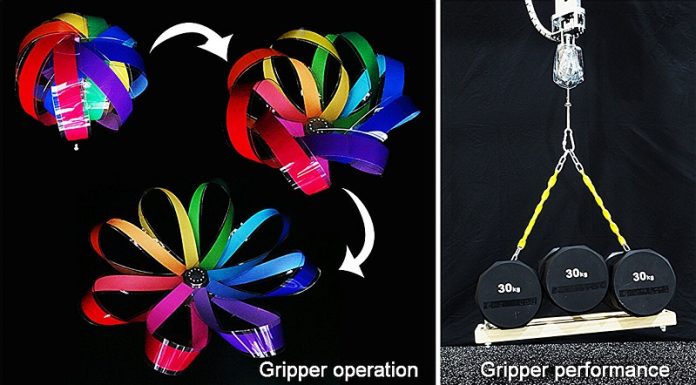
Picture a robot hand that is as light as a chocolate bar but has the super-strength to lift something as heavy as two adult humans! Sounds like something out of a science-fiction movie, right?
But, two brilliant minds, Dr. Song, Kahye and Professor Lee, Dae-Young from South Korea have turned this fantasy into a reality.
Their latest invention in the realm of robotics, a soft gripper, can hoist objects that weigh over 100 kg, while the gripper itself weighs a mere 130 grams.
Their research was spotlighted in the journal Nature Communications.
Let’s dive into the amazing world of soft robotic grippers! Imagine a robot hand made from soft and gentle materials like cloth, paper, or silicone.
Unlike their hard and rigid cousins, soft grippers are gentle and flexible, making them perfect for handling fragile objects like eggs or carefully dealing with various objects in a logistics setting.
The challenge with them until now has been that they couldn’t lift very heavy objects and would often lose grip easily when nudged or bumped.
Here’s where the innovation from our science duo comes in. Instead of trying to create an entirely new material or bolstering its structure in conventional ways, they turned to an age-old technique that we use in making our clothes, bags, and more – weaving.
The strength of weaving lies in taking individual threads and intertwining them so tightly that they create a robust and strong fabric. This concept was applied to create the soft gripper, using thin PET plastic, a commonly available and affordable material.
By designing strips of this plastic to weave together, creating a tightly knit structure, a surprisingly light yet sturdy gripper was born.
Weighing in at only 130 grams, this robot hand can securely grip and lift a massive weight of 100 kilograms.
To give you a comparison, traditional grippers of the same weight can only manage to lift up to 20 kilograms.
What makes this so mind-blowing is the cost-effectiveness and efficiency of the manufacturing process. The plastic material utilized costs only around $2 per unit, making it a highly affordable solution. Plus, the assembly of the gripper is a breeze!
Simply fastening a plastic strip together can create the gripper in less than 10 minutes, offering a swift and straightforward maintenance and replacement process.
The versatility doesn’t stop there. Although PET plastic was the primary material for the team’s research, the gripper can be crafted using a range of materials, such as rubber or other elastic compounds.
This allows customization for various needs, whether it’s for an industrial setting requiring a firm grip or situations demanding endurance in extreme conditions.
Dr. Song highlighted that the gripper developed by KIST and KAIST maintains the benefits of a soft robot yet manages to grasp heavy objects like its rigid counterparts. With the ability to be manufactured in a plethora of sizes, it can manage objects of different shapes and weights, from slim cards to delicate flowers.
This opens up a world of possibilities, ushering in a future where these mighty mini robot hands could be utilized in industries, logistics, and even our households, managing tasks that require a gentle yet sturdy grip.
This innovation provides a giant leap toward resolving the long-standing issues associated with soft grippers in robotics, promising a future where robots can handle a diverse range of objects, from the most delicate to the considerably heavy, with ease and precision.
So, the future of robotics seems to be not just soft and gentle, but also incredibly strong and versatile!
Follow us on Twitter for more articles about this topic.
Source: Korea Institute of Science and Technology.



